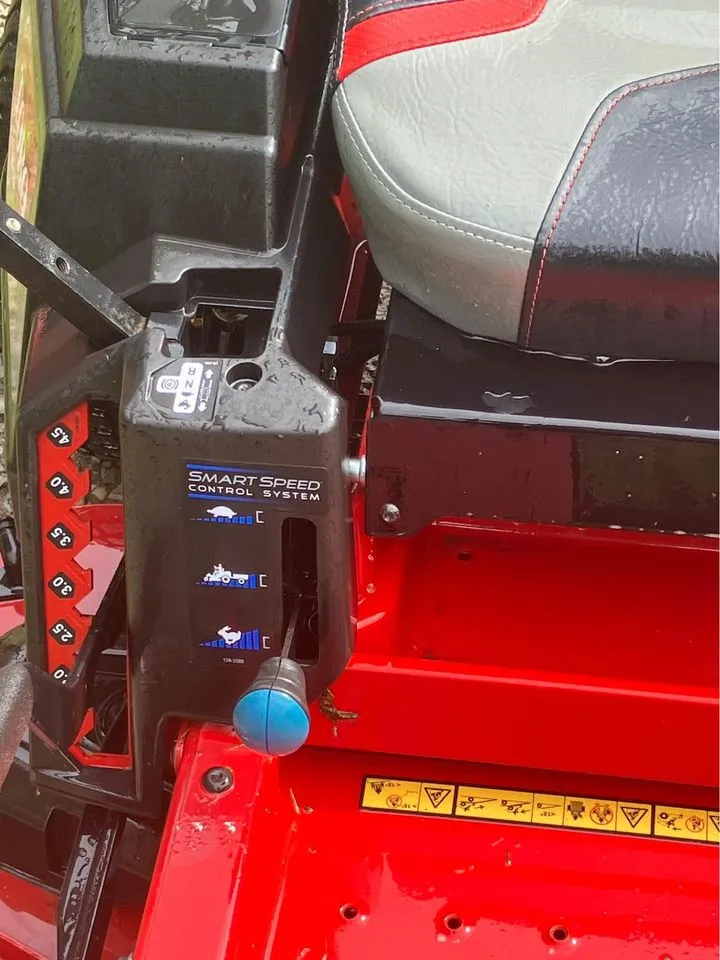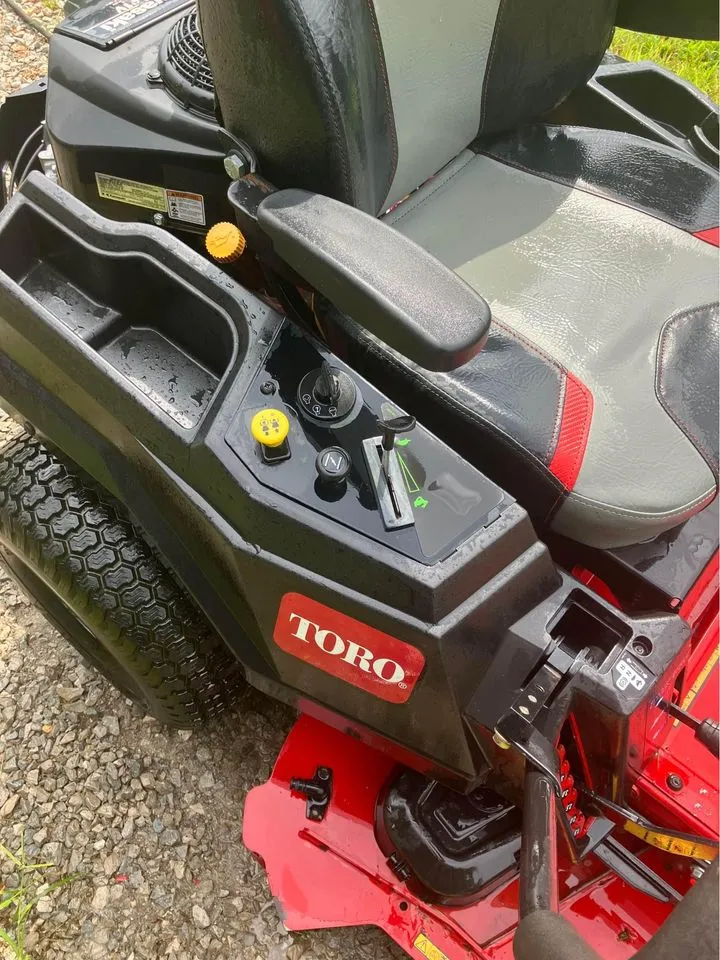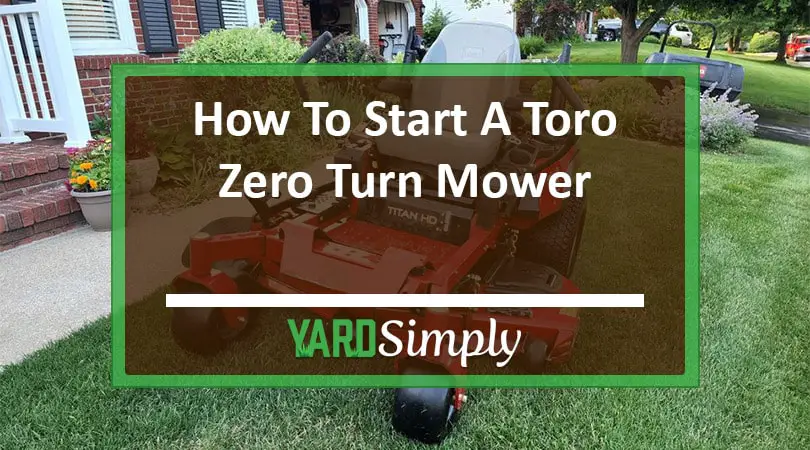As a seasoned landscape professional with extensive experience in operating and maintaining a variety of lawn care equipment, I bring a depth of knowledge to the topic of starting a Toro zero turn mower.
Ensuring your mower operates efficiently is critical, and it begins with the start-up process. This guide will take you through the essential steps to start your Toro mower reliably, covering crucial checks and procedures without unnecessary detail.
Trust in my expertise as we delve into a straightforward, no-nonsense approach to get your machine up and running.
Let’s get started.
Key Takeaways
- Essential Start-Up Procedure: Ensure correct seating position, engage the parking brake, set the throttle appropriately, turn the ignition key to start, and then allow the engine to warm up for smooth operation.
- Safety and Preparation: It highlights the need to follow the correct starting procedure, which includes properly seating oneself, engaging the safety features, and testing the interlock system to ensure it functions correctly before starting the engine.
- Troubleshooting Tips: The article also addresses common issues that might prevent the mower from starting, such as stale fuel, battery problems, clogged air filters, and malfunctioning safety switches, offering practical solutions for each.
- Maintenance and Care: The author shares personal experiences, stressing the importance of regular maintenance and care for the Toro zero turn mower, which not only ensures easy start-ups but also prolongs the equipment’s life and performance.
How to Start a Toro Zero Turn Mower
- Inspect the Mower for Loose or Damaged Parts
- Check Fuel and Oil Levels
- Locating the Ignition
- Proper Seating Position
- Engaging the Brakes
- Setting the Throttle
- Turning the Key
- Let the Engine Warm Up for a Few Minutes
Inspect the Mower for Any Loose or Damaged Parts
I’ll conduct a thorough safety check to ensure all mower components, such as the blade assembly and engine housing, are secure and intact before starting my Toro zero turn mower. I’ll inspect the toro lawnmower carefully, looking for signs of wear or damage.
On a riding lawn mower like this, it’s crucial to check the spark plug and air filter as well, as any issues with these can affect performance. I make sure that the spark plug is properly seated and the air filter is clean and free from obstructions.
If there’s a loose part, I’ll tighten it, and if something’s damaged, I’ll know it’s time for a repair before I proceed. Safety always comes first, especially when I’m about to operate powerful equipment like my zero turn mower.
Also Read: Toro Zero Turn One Side Not Working: Issues & Solutions
Check Fuel and Oil Levels
After my mower’s safety inspection, I check the fuel and oil levels to ensure they’re adequate for the engine to run smoothly.
Peering into the petrol tank, I confirm there’s enough gasoline to complete my mowing tasks. Running out of fuel mid-job is a hassle I prefer to avoid.
Next, I pull out the oil dipstick to check the oil level. It’s vital for protecting the engine’s moving parts and ensuring longevity. If it’s low or the oil appears dirty, it’s time for an oil change.
Neglecting this could lead to engine damage, which is a headache I definitely don’t need.
With both fuel and oil at the right levels, I’m confident my Toro zero turn mower is ready to start.
Read More: What Kind of Oil to Use in a Husqvarna Zero Turn
Locating the Ignition
This switch is the gateway to activating the tractor’s engine, essentially waking up the spark plugs that ignite the fuel. It’s crucial to ensure that I’ve got the right key; it usually has a distinct shape to fit the switch.
Proper Seating Position
I must ensure I’m seated correctly, with my back against the seatback and both feet resting on the footplate. This isn’t just for comfort – it’s essential for safety and control when operating my riding lawnmower.
Engaging the Brakes
The brake system is essential for safety. The parking brake, often referred to as the emergency brake, must be set to prevent the mower from moving unexpectedly.
I check that the brake lever is in the correct position, usually indicated by clear startstop markings or a distinct notch.
Only then do I feel confident to proceed. It’s a critical step, one I never overlook, because starting the engine with the brake disengaged could lead to unintended movement or even an accident.
Ensuring the brake is set is a habit that’s second nature to me now.
Setting the Throttle

I’ll now set the throttle to the appropriate starting position, typically found between the slow and fast settings, for optimal engine ignition. It’s crucial to adjust it properly to ensure my lawn mower starts smoothly.
If the engine is cold, I might need to use the choke to enrich the fuel mixture. For models with a recoil start, this step primes the engine to turn over with less effort when I pull the cord.
With the throttle set, I’m ready to move on to the actual starting process. By paying attention to the throttle’s position, I’m giving my Toro zero-turn mower the best chance to roar to life without a hitch.
Turning the Key
Having set the throttle, I now turn the ignition key to start my Toro zero turn mower. This action feels almost instinctive, like starting my car.
The sound of the engine assures me that it’s time to tackle the grass, guiding the zero turn mower over the lawn with precision and ease.
Let the Engine Warm Up for a Few Minutes
Once the mower’s engine springs to life, I let it idle for a few minutes to warm up before mowing. This warm-up period is crucial, especially when starting my Toro zero turn mower for the first time of the day or in cooler weather.
Allowing the engine to warm up helps the oil circulate properly, which is vital for lubricating the moving parts. The fuel pump gets a chance to feed the carburetors steadily, ensuring the mower operates smoothly once I begin the task at hand.
A proper warm-up means a healthier engine and a more efficient cutting session. It’s a simple step, but it makes a significant difference in the performance and longevity of my Toro’s engine.
How to Test the Interlock System
Before I fire up my Toro zero turn mower, I make sure the interlock system is functioning properly. This safety feature prevents the engine from starting unless certain conditions are met.
I’ll walk you through how to test the seat switch, blade engagement switch, brake safety switch, and control levers to ensure they’re all in working order.
Understanding the Interlock System
The safety switch is nestled within the mower’s circuitry, ensuring that all conditions are right before the ignition process can begin.
To test it, I’ll simulate various scenarios. I’ll check if the mower starts when the safety conditions aren’t met. If it does, there’s likely an issue with a safety switch or the relay, which communicates between the safety switch and the alternator.
A successful test means all systems are go, and the mower won’t start until I’m ready and it’s safe to do so.
Test Seat Switch
I’ll start testing the interlock system by checking the seat switch, a critical component that ensures the mower only operates when I’m properly seated.
To do this on my Toro zero turn mower, I’ll need to locate the seat switch under the seat’s suspension. It’s usually connected to a plunger or pressure mechanism that activates when I sit down.
I’ll press down on the switch to simulate the pressure of sitting. If the engine doesn’t turn off when I stand up, then I know something’s up with the switch.
It’s essential to ensure the seat switch functions correctly because it’s a safety feature designed to prevent the mower from running without an operator.
Testing it regularly is part of maintaining my Toro’s safety protocols.
Check Blade Engagement Switch
After testing the seat switch, I’ll move on to inspect the blade engagement switch to ensure it properly halts the blades when disengaged. This is a crucial step for safe lawn mowing.
For my zero turn mower, I’ll ensure the mower is parked on a flat surface before I proceed. I’ll start the engine and engage the blade switch momentarily, then quickly disengage it.
The blades should come to a complete stop. If they continue to spin, there’s an issue.
I’ll turn off the engine and check the switch’s connections. Sometimes, debris or wear can cause malfunctions. If everything seems intact, but the blades won’t stop, I’ll know it’s time to seek professional help.
It’s essential for the safety of my mowing operations that this interlock system functions correctly.
Verify Brake Safety Switch
The brake safety switch is a key safety feature on lawnmowers designed to prevent the mower from operating if the brake isn’t engaged. Wearing my protective gear, I sit in the mower seat and firmly press down on the brake pedal.
Then, I attempt to start the mower. If it starts up without the brake engaged, there’s a problem with the safety switch.
Conversely, if it doesn’t start unless the brake is properly engaged, the interlock system is working as intended and I can proceed with confidence.
Test Control Levers

I carefully push and pull the control levers to their designated neutral spots. If the mower starts with the levers out of place, there’s a risk of immediate recoil, which can be dangerous.
By confirming the interlock system is engaged, I ensure the mower will only roar to life when it’s absolutely safe to do so.
It’s a quick but crucial step before I get down to mowing.
Perform General Operation Check
Before I engage the ignition, it’s essential to check the mower’s interlock system to ensure it’s functioning correctly. This general operation check is a safety must-do.
I start by making sure that the Toro zero turn mower’s tank has enough fuel. Then, I inspect the fuel injectors or carburetor, depending on the model, for any signs of blockage or wear.
It’s crucial that these components are in good shape to prevent any startup issues or engine damage.
Next, I test the interlock system by sitting in the seat, applying the brake, and engaging the control levers.
If the system is working properly, the engine shouldn’t start unless all these conditions are met, ensuring that the mower operates safely when I’m ready to go.
Related Articles:
Conclusion
As someone who’s spent countless hours behind the wheel of a quality Toro zero turn mower, I can confidently say that starting it up is usually a breeze, thanks to a good routine check of the interlock system and ensuring all the basics are covered.
Sure, there are days when it acts up and refuses to cooperate. When this happens, I don’t panic. Instead, I revisit the essentials like the fuel level, battery, and spark plug, and double-check all safety features.
Through my own experiences, I’ve learned that regular maintenance is key to keeping these minor hiccups at bay.
So, from one mower enthusiast to another, keep up with your Toro’s care, and it’ll serve you well on the lawn!
Frequently Asked Questions
What is the proper procedure to start a Toro zero turn mower?
This question typically seeks a step-by-step guide on the starting process, including safety checks, seating position, and the use of controls and ignition.
Why won’t my Toro zero turn mower start?
This is a common troubleshooting question focusing on common issues like battery problems, fuel issues, or ignition system malfunctions.
Do I need to prime the engine of my Toro zero turn mower before starting it?
This question addresses whether there’s a need for manual priming of the engine, particularly in models where this is a necessary step.
How can I safely start a Toro zero turn mower on a slope or uneven terrain?
Safety concerns are paramount, and this question seeks advice on the correct method to start the mower when it’s not on a flat surface.
What maintenance should I perform on my Toro zero turn mower to ensure it starts reliably?
This question is about preventative maintenance and the steps owners can take to ensure their mower starts smoothly every time, including tips on fuel management, battery care, and general engine maintenance.


